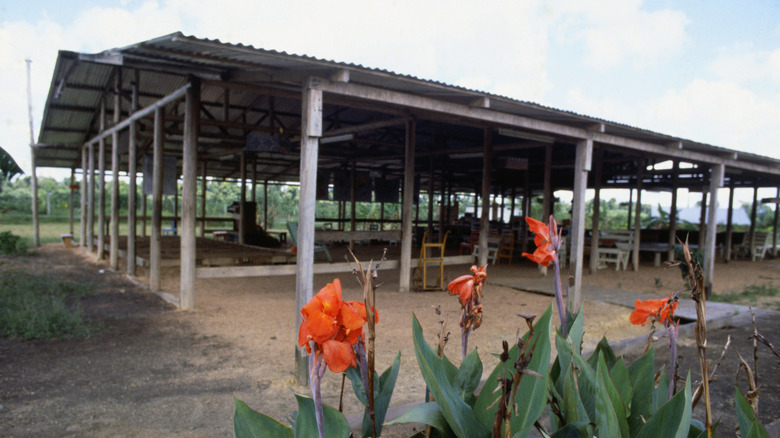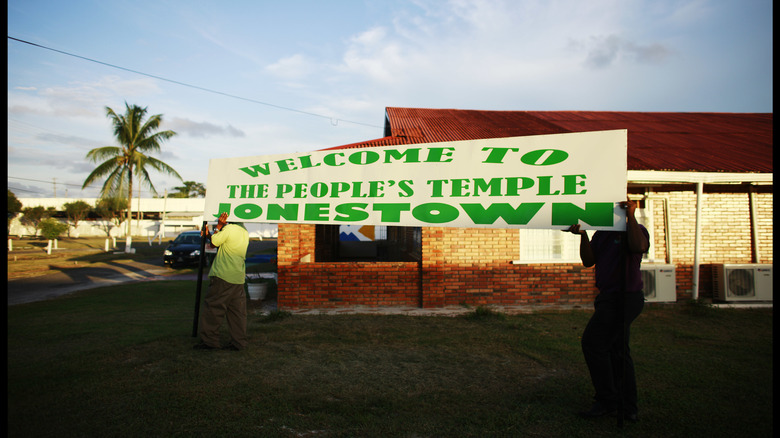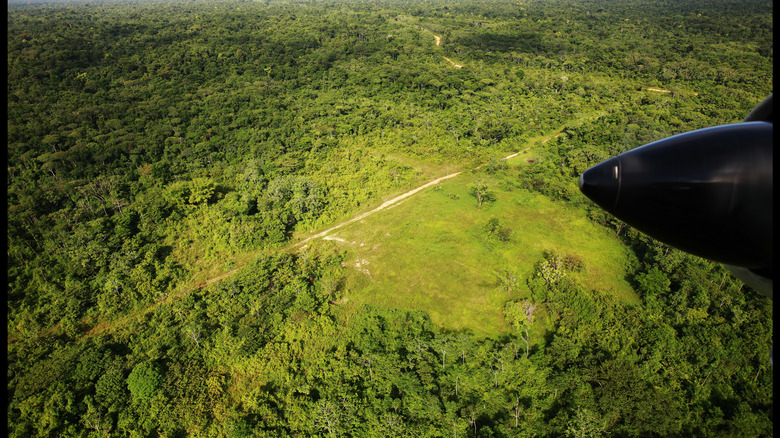The South American Destination That Seems Way Too Creepy To Be A Tourist Attraction
In 1978, something happened in the small South American country of Guyana that shocked the world. Over 900 people — many of them children — committed mass murder-suicide by downing cyanide-laced punch at a religious compound deep in the country's interior. The Peoples Temple — also called "Jonestown" after the group's leader, Reverend Jim Jones — was home to an American spiritual movement that many described as a cult, and what went down that day fateful caused Guyana itself to become synonymous with tragedy.
For decades, the Jonestown site has rotted away in the jungle, the remnants of a dark memory that many would rather forget. It's inaccessibility — you can only get there by plane, helicopter, or boat — and its reputation as a major crime scene has largely kept people away. This is changing, however, as an agreement between the Guyanese government and a local tour operator means that tourists will now be able to visit this macabre piece of the past.
According to Wanderlust Adventures owner and operator Roselyn Sewcharran, the excursion will be mainly educational. "The thing is, Jonestown remains a tragic part of Guyana's history, but it is also an event of global significance," she told NBC News. "It offers critical lessons about cult psychology, manipulation and abuse of power."
Opening the gates to a very dark place
The notion and popularity of dark tourism — people seeking out places precisely because they're associated with death and tragedy — is nothing new. From the Chernobyl exclusion zone to the Catacombs of Paris, visitors have long been flocking to unnerving dark tourism destinations that were once steeped in blood and catastrophe. Dark tourism is also a very big business, worth tens of billions of dollars worldwide.
In this sense, opening up Jonestown to visitors is no different than, say, tours of Auschwitz, the infamous Nazi extermination camp in Poland. It's part of a tradition where visitors can satisfy their morbid curiosity and reflect on the past while also supporting the local economy. This has surely helped rally the Guyana government behind the initiative. According to the AP, Tourism Minister Oneidge Walrond is enthusiastically backing the project. "It certainly has my support," she said. "It is possible. After all, we have seen what Rwanda has done with that awful tragedy as an example."
That said, not everyone in Guyana is on board. The SF Gate reports that Neville Bissember, a law professor at the University of Guyana, attacked the idea of the tour, calling it "ghoulish and bizarre" in a recent letter. "What part of Guyana's nature and culture is represented in a place where death by mass suicide and other atrocities and human rights violations were perpetuated against a submissive group of American citizens, which had nothing to do with Guyana nor Guyanese?," he wrote.
What is there to actually see?
One issue with bringing tours to the Jonestown site is that there is simply so little of it left. At its height, the Peoples Temple commune occupied 300 acres of fertile farmland with over 100 buildings. In the 1980s, what was left of the compound is believed to have been destroyed in a brush fire, and today, all that remains are the ruins of a cassava mill, a few pieces of the main pavilion, and a rusted tractor.
This means that there is actually very little for visitors to see. There is also the issue of location. Not only is the site far from Georgetown — Guyana's capital and one of South America's more dangerous destinations — but it's also overgrown, surrounded by thick jungle, and more than 6 miles from the landing strip at the little village of Port Kaituma, via a crude bumpy dirt track. Transforming the site into a working tourist attraction will take considerable effort and resources.
Whatever the obstacles, they won't likely deter determined dark tourists from visiting the Jonestown site. While some people will surely be drawn out of morbid curiosity, the simple desire to understand the past is also a driving force. "A lot of people just don't get dark tourism — they think it's tourists acting macabre, that they're trying to take pleasure in death," Gareth Johnson, founder of Young Pioneer Tours — a company that specializes in dark destinations — told travel site Roadbook. "Tourists want to know why this happened, how it happened."


